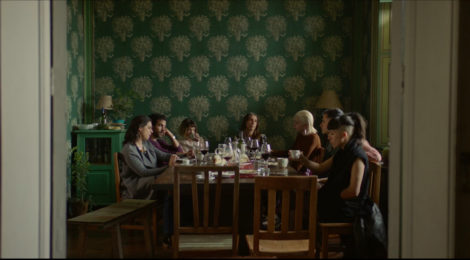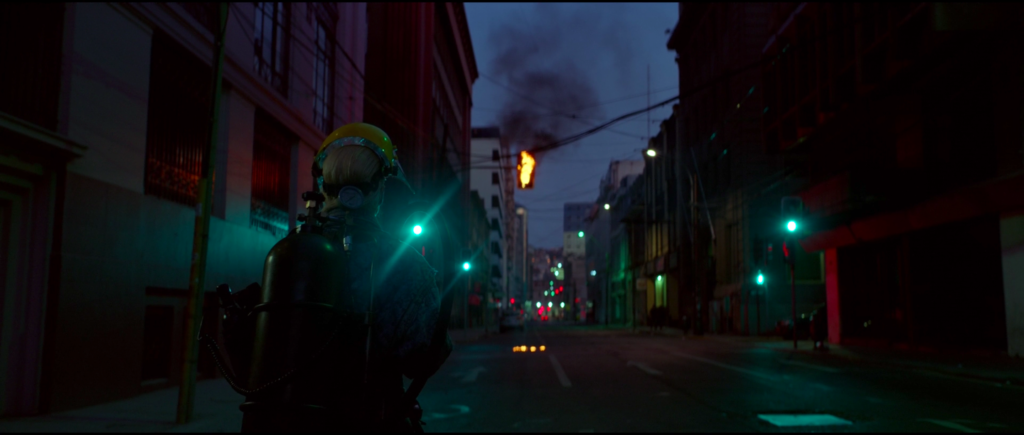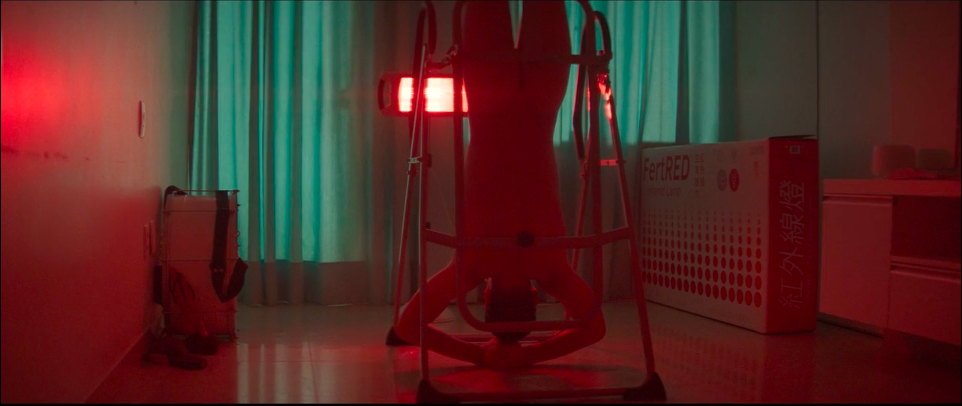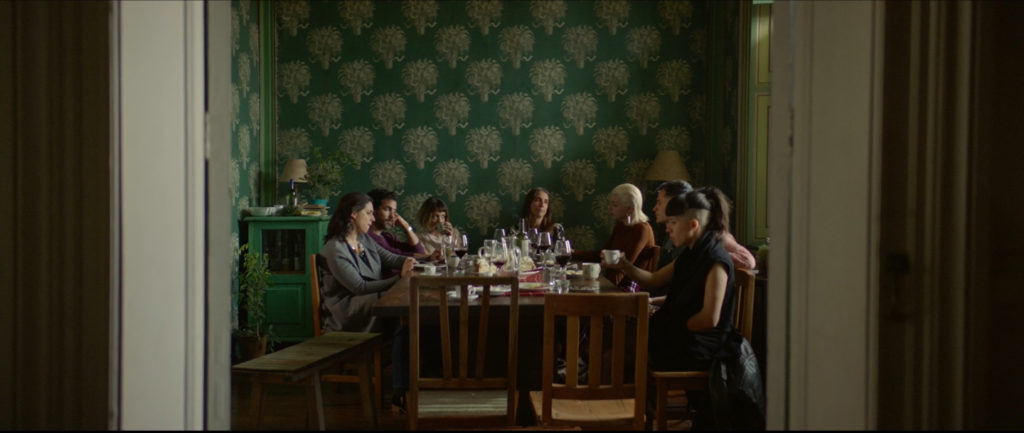
Alternative Reproductive Futures in Ema and Divino Amor
By Rachel Randall*
Ever since watching Ema (Pablo Larraín, 2019) and Divino Amor [Divine Love](Gabriel Mascaro, 2019) for the first time when they were screened alongside each other at the BFI London Film Festival 2019, I was struck by the narrative and aesthetic similarities between the two films – both of which stuck in my mind long after I had left the cinema. Set in dystopian urban spaces, the Chilean Ema sees its eponymous protagonist (Mariana di Girólamo) repeatedly set fire to various objects across the vibrant port-city of Valparaíso, while Divino Amor takes place in a Brazilian city in the year 2027 after the country has been transformed by a wave of conservative religiosity. Their futuristic, ethereal qualities are reinforced by both films’ use of bright lighting in dark cityscapes. Ema’s initial scene features flaming, flashing traffic lights (Figure 1). It is shortly followed by a sequence that shows Ema and her dance troupe bouncing and gyrating in front of what appears to be a large, burning sun or multicoloured fireball. Neon lights (now a hallmark of Mascaro’s filmmaking) glow throughout Divino Amor, including at its opening when protagonist Joana (Dira Paes) and her husband Danilo (Julio Machado) dance energetically at a large, night-time celebration that has been organised by their church (‘Divino Amor’).

Both narratives initially circle around Ema’s and Joana’s frustrated desires to conceive biological children. This is a fact that alludes to the anxieties about the future that these films are exploring against the backdrop of their unsettling urban atmospheres. Infants are often deployed in cultural narratives as ‘universal’, sentimental symbols of a heteronormative ‘reproductive futurism’ in which the figural child is used to embody ‘the telos of the social order’ and is the one ‘for whom that order is held in perpetual trust’ (Edelman 2004: 11). As Lee Edelman has argued: ‘we are no more able to conceive of a politics without a fantasy of the future than we are able to conceive of a future without the figure of the child’ (2004: 11). However, a crisis of hegemonic masculinity is signalled in both films via the trope of infertility: neither Ema’s choreographer-boyfriend Gastón (Gael García Bernal), nor Joana’s husband Danilo can get their partners pregnant. In Larraín’s film, this culminates in Ema deriding Gastón as a ‘chancho infértil’ [‘infertile pig’] and telling him: ‘eres un condón humano: nunca me vas a dar un hijo’ [‘you are a human condom: you’re never going to give me a child’]. In Mascaro’s film, the audience is treated to the ludicrous spectacle of Danilo positioning himself upside down, naked, in front of an infrared lamp – testicles akimbo – as he experiments with a new fertility treatment (Figure 2).

The child that Ema longs to mother, and the infants that both Ema and Joana eventually conceive, are mysterious, troubling figures. None of them are the biological products of the protagonists’ romantic relationships to their primary partners. Unsurprisingly, however, all of their children are boys, whose association with teleological historicity and the public realm means that they are generally used (rather than girls) to symbolise the national future, or in the case of these films, to raise ambivalent questions about it. Ema and Gastón struggle with the guilt provoked by their decision to give up their adopted son, Polo, after they became unable to cope with his rebellious behaviour. The film’s dialogue suggests that Polo is marked by racial difference when a public official says that nobody wants to adopt Colombian or Venezuelan children (like him): a comment that provides a troubling insight into what constitutes the idealised Chilean family. Polo himself does not appear until over half an hour into the film and, at this point, the audience is still uncertain of his identity. In Divino Amor, the film’s conclusion attributes the unsettling, infantile voice of its omniscient narrator to Joana’s son, whose birth via caesarean section has just been depicted. The voiceover’s opening statement (‘It was 2027’) reveals that her son has been narrating the film from a position in the future. It playfully implies that he may be the Messiah: the embodiment of her church’s eagerly awaited ‘second coming’.
Ultimately, both films play on questions of paternity and plural desires in such a way as to thoroughly undermine heteronormative, patriarchal family structures. Ema’s skills as a ‘galana’ (a feminized version of the Spanish term for ‘ladies’ man’), who seduces almost everyone she meets, allow her to become romantically involved with both of Polo’s new adoptive parents (and husband and wife), Aníbal (Santiago Cabrera) and Raquel (Paola Giannini). Ema eventually becomes pregnant with Aníbal’s child. The paternity of Joana’s son is initially uncertain in Divino Amor as a result of the spiritually sanctioned swinging sessions that are organised by her church and of which she and her husband regularly partake. When Joana becomes pregnant, she believes the father must be one of the other men who attends her prayer group, but ultimately cannot discover his identity and argues that the conception is a divine miracle. Her son’s final remark on the film’s voiceover skewers the symbolic importance given to patriarchal structures in Brazil by ironically invoking the mystery surrounding his paternity: ‘quem nasce sem nome, nasce sem medo’ (‘he who is born without a name, is born without fear’). Joana is abandoned by her husband before her son is born, while at Ema’s conclusion, Gastón, Aníbal and Raquel look on, quietly horrified, as the protagonist explains to her friends and family the plan that has dictated her actions throughout the film: to remain close to Polo by having his adoptive father’s baby, thereby giving him a brother and creating an extended, non-traditional family (Figure 3).

These films’ critical meditations on patriarchy, monogamy and heteronormativity are not, nonetheless, limited to the level of the interpersonal relationships they depict; they also interrogate the (corrupt) state’s desire for biopolitical control over family life – a common theme in contemporary Latin American films with child protagonists (Randall 2017). In Ema, the audience eventually learns that Ema and Gastón were only able to adopt Polo originally because of the intervention of an unscrupulous public servant called Marcela (Catalina Saavedra) who accepted a bribe from the couple in return for altering their paperwork. Towards the beginning of the film, she and Ema argue as they walk along the street and a Chilean flag can be seen hanging, limp in the background (Figure 4).

Marcela later yells at the pair: ‘¡El sistema está hecho para eliminar a la gente como ustedes y yo soy el sistema, huevones!’ (‘The system is made to eliminate people like you and I am the system, you idiots!’). In Divino Amor, Joana works as a notary at a registrar’s office; a sticker of the Brazilian flag is visible on a filing cabinet behind her desk (Figure 5). Despite the state’s supposedly secular nature, Joana abuses her position by interfering in the relationships of those who come to see her in order to process their divorces. She imposes her religious values on them by persuading them to heal their relationships and keeps mementos of couples whose marriages she has helped to ‘save’ in a cupboard-cum-shrine in her home.

These films’ implicit criticisms of state apparatuses signal that they are exploring specific fears related to Chile’s and Brazil’s contemporary contexts and possible futures. Divino Amor was released the year after President Jair Bolsonaro’s election victory in 2018 and arguably plays on the possible outcome of his close ties to Edir Macedo: the founder of the popular evangelical church Igreja Universal do Reino de Deus (Universal Church of the Kingdom of God – IURD). Macedo is one of the richest religious leaders in the world and a media mogul. He was arrested in 1992 on charges of fraud and charlatanism (De Souza 2005: 25). In 2009, he and other leading members of his church were accused of embezzling worshipers’ donations. The neon symbol used by the religious organisation in Divino Amor evokes the IURD’s well-known logo, which depicts a dove surrounded by a red heart (Figure 6). Evangelical Christianity in Brazil is strongly associated with social conservatism and the triumph of its influence is symbolised in the film by a sequence that shows Joana and other women on the beach wearing full-body swimsuits.

In Ema, the protagonist’s commitment to establishing an unorthodox, extended family unit – with herself at its centre – can be interpreted as a rejection of the ‘traditional’, patriarchal family that has been so strongly revered in Chile, particularly under General Augusto Pinochet’s military rule (1973-1990). The influence of his regime lingers on: in May this year, President Sebastián Piñera appointed Pinochet’s great-niece, Macarena Santelices – who is known for having praised the ‘good side’ of his dictatorship – as Chile’s minister for women’s rights and gender equality. By June, Santelices had been forced to resign following a public backlash. In Larraín’s film, Ema’s anarchic impulse to burn down and then reclaim the city, by dancing provocatively across its expanse with her female friends, draws on Valparaíso’s association with counter-culture and pre-empts the nature of the anti-government protests that swept across Chile in October 2019, some months after the film’s release. During the protests, the feminist theatre collective LasTesis staged the first performance of ‘Un violador en tu camino’ (‘A Rapist in your Path) in Valparaíso on 20 November 2019. They carried a sign reading: ‘Fuego: El arte fuera de sala’ (‘Fire: Art outside the Classroom’). Their public intervention, which has since been adapted and re-enacted by groups of women in multiple countries, denounced rape culture and allied it to the violence enacted by the patriarchal state. Its lyrics resonate with those that feature in the song ‘Real’ by E$tado Unido to which Ema dances and sets the city ablaze: ‘fanning my flames doesn’t give you power / your government is violence’.
While both Ema and Divino Amor celebrate corporeal expression, affective connection and sexual desire, they also emphasise the fact that these impulses can be co-opted by distinct forces, culminating in very different political futures.
Acknowledgements: I would like to thank Rachel Daisy Ellis at Desvia Films for supplying me with access to a copy of Divino Amor while I was writing this blogpost.
Works cited
Edelman, Lee. 2004. No Future: Queer Theory and the Death Drive. Durham: Duke University Press.
Randall, Rachel. 2017. Children on the Threshold in Contemporary Latin American Cinema: Nature, Gender and Agency. Lanham: Lexington Books.
Souza, André Ricardo de. 2005. Igreja in concert: padres cantores, mídia e marketing. São Paulo: FAPESP.
Bio
Rachel Randall is Lecturer in Hispanic Media and Digital Communications at the University of Bristol. She is the author of Children on the Threshold in Contemporary Latin American Cinema (Lexington Books, 2017). The book contends that child characters have taken on a critical representation role in Latin American film because of their position on the boundary between nature and culture, which converts them into a focus of, and a limit to, state or colonial biopower. Rachel’s current project, which was funded by the Leverhulme Trust, examines the depiction of paid domestic workers in post-dictatorship Latin American cultural production, including: film, documentary, digital culture and testimonio (literary testimony). It will be published by the University of Texas Press as Paid to Care: Domestic Workers in Contemporary Latin American Culture.






